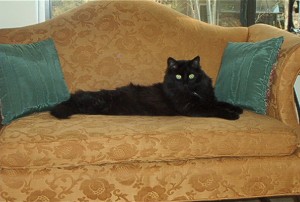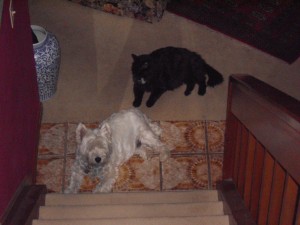Pets often have schedules that come from their personal inclinations, urges, and habits, especially as they age. It’s interesting to observe the regularity of actions on their parts that can be clocked with frightening dependability.
Riggs is a rescue cat we’ve had for at least ten years, a feline whose vocal abilities as rather a bad singer were probably what prompted his original owners to abandon him. He’s a gentle creature with a geriatric disposition revolving around his carefully planned schedule each day, a schedule that he alone determines. As Riggs was about five when he was rescued, we estimate his present age to be about fifteen or sixteen.
At six in the morning he begins singing downstairs in order to let everyone know that the day is supposed to begin, whether or not others in the house are quite yet able even to open their eyes without effort. He expects to be petted immediately and spoken to in a cooing, quiet tone that reassures him that he is still loved. He then scampers down to the sun room, where on an old desk we keep his food and water, above a level the dog is capable of invading. After his breakfast, Riggs greets Dudley, our dog, in a nuzzle with the side of his face (or maybe just using Dudley as a napkin), as Duds stands there patiently, hoping that Riggs has completed his vocal exercises for the day. Next stop for our cat is the camel back sofa in the master bedroom, where Riggs curls up for the rest of the morning, knowing that Dudley won’t bother him, as our dog will never venture upstairs unless there is a thunderstorm, requiring assurance that the world is not about to end.
Around four o’clock, Riggs comes downstairs again for some lap time while I’m watching Judge Judy on television, possibly rendering him a cat who has been exposed to more legal data than has any other cat in the united States. He’s now broken the record of my sister’s cat, Atticus, who used to watch Perry Mason.
The most active part of Riggs’ day is at almost exactly five o’clock, when he provokes Dudley into chasing him around our open stairway, through the dining room, hallway, and library. This is how the two get most of their exercise, running in that circle every afternoon until Riggs sneaks up three of four stairs to rest quietly, one paw crossed over the other in a decadent display of quietude and to enjoy Dudley’s continuing to run in circles below him. Riggs will usually look at me if I’m nearby and give me a look of profound wisdom and superiority over what he undoubtedly believes is hopeless canine stupidity on the part of poor Duds, who eventually figures out that he has been duped once again by Riggs, who continues to look down on him while Dudley barks his extreme displeasure.
Early evening is the time for Riggs to go to his favorite wing chair in our little library, where he curls up for the night before his next singing performance the following morning.
Dudley’s schedule seems intertwined with that of Riggs, though Dudley feels a deep sense of responsibility in going out to the dog run several times a day to let the world know that he’s on guard duty. Both Dudley and Riggs have magnet sensors on their collars, which allow them to activate the electric pet door in the sun room, which leads out to the dog run and fenced garden. Occasionally both pets can be seen together sunning themselves beside our big blue spruce tree. When one pet is at the vet being groomed or otherwise not around when he’s expected to be, the other will fret. Even when Dudley was a puppy, Riggs was patient with him, never biting or using his claws. It was as though he knew Dudley was really no threat, and that they were both a part of this household, a place that both of these wonderful animals make a home, not just for themselves, but for us humans as well. JB







